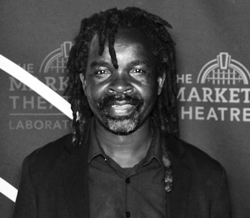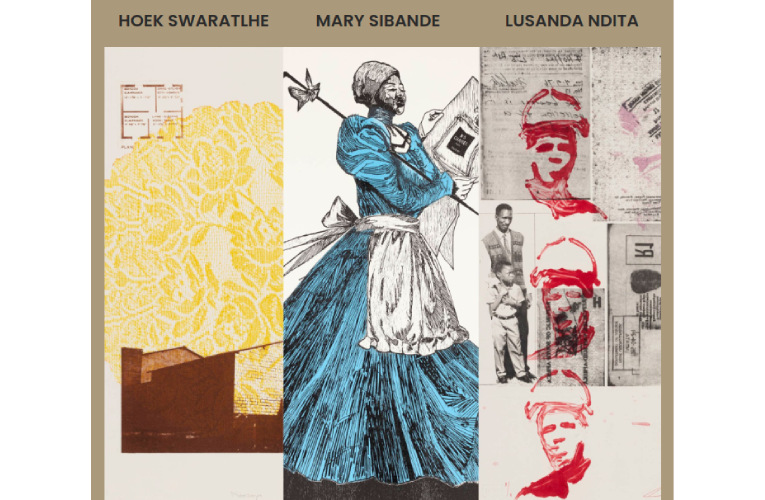Reclaiming Quarters exhibition takes you into a past defined by spatial planning
That complex past relegated the urban poor into substandard living quarters as domestic workers and labourers.
By Edward Tsumele, CITYLIFE/ARTS Editor

If you walked into David Krut Gallery in Parkwood right now, you would come into an encounter, and a conversation with what feels like a township scene in a backroom somewhere else and not suburbia. Such as Mamelod, Atteridgeville in Pretoria, or even Soweto of the old though. These scenes are well captured by photographic collages in a form of prints that are on the walls of this gallery. Some of the collages are those of portraits of people in various poses, proud and ready to be capture on camera by the photographer. You would also quickly pick up that these images were not photographed recently. Not the 1990s, and perhaps not even the 1980s for people by that time people did not pose for pictures in the manner depicted by these images’ subjects or models.
For example who would you spot posing to a car that they did not own in contemporary times? .An old car for that matter, which in today’s consumer tastes could be declared a scrap yard, ready for recycling. A valueless object, a relic from the past that nobody would want to be seen driving on the road, let alone captured for posterity on camera posing next to it. You get the drift. I am sure by now you very well understand that these images stand out on their own. I mean these collages that have been reassembled from newspaper cuttings and old pictures to create a narrative that revisits the concept of quarters –the living substandard houses that were for maids- those working for the wealthy in suburbia.
This is exactly what makes this exhibition an important exhibition, and therefore these artworks, which are collages carrying complex histories of inequalities and glaring disparities for those who worked as domestic workers, factory workers and cleaners, valuable. The exhibition goes back deep into history and captures the socio political and the personal to create a narrative that is fascinating and in a way makes a viewer think deep about that era and what life was for ordinary folk that left their rural areas to find work in big cities like Johannesburg.
The Reclaiming Quarters exhibition, currently housed in the David Krut Gallery is a window into a distant past when life was lived differently and the experiences of those that found themselves in the big city are a stark difference to a life lived by generations later. This exhibition gives a viewer an opportunity to travel into the distant past to imagine how life was lived and experienced then, a stark contrast to what the urban folk, for example who work in suburbia experience life now. Even if you never lived in that past, the exhibition will make you feel like you are going into that uncomfortable past to retrieve that complex history of the relationship between power, money and servitude, accentuated by spatial planning.
Reclaiming Quarters is a group exhibition by artists Mary Sibande (who is also a mentor to some of the younger artists exhibited here), Lusanda Ndita and Hoek Swaratlhe.
“David Krut Projects is pleased to present Reclaiming Quarters, a collective exhibition by Mary Sibande, Lusanda Ndita, Hoek Swaratlhe of work made in collaboration with printer Sbongiseni Khulu at the David Krut Workshop,” says a statement from the gallery.
When the exhibition opened October, 19th 2024 at David Krut Projects, The Blue House, 151 Jan Smuts Ave. Parkwood, those who attended the event were visibly in awe of the representation of this past that today only lingers as either a fading memory for those that are old enough, or an imaginary past that can only be captured and though of through for example the DNA memories for a younger generation as registered by their forebears who lived in that past.
How did this project come about? Well, in late 2023, the David Krut Workshop (DKW) was approached to collaborate as part of The Occupying the Gallery mentorship programme, established by Mary Sibande and Lawrence Lemaoana. The aim of the programme is to introduce a number of artists from different backgrounds to the world of art and the myriad of spaces/opportunities therein. As a collective the artists would “take up residence in and transform an otherwise used space into an active open working environment that offers access into artistic processes” to create works that are then showcased, moving through the different aspects of collaboration, printmaking and institutions as they go, explain the curators of this collaborative effort. This is an important one as it allows older and seasoned artists such as Sibande to experiement with new techniques, while younger artists who are part of this exhibition were able to expand their knowledge and technique during the process of creating this body of work.
“This exhibition delves into the notion of “quarters” as a potent symbol of spatial control and the dehumanizing conditions imposed on non-European people during South Africa’s apartheid era. The term “quarters” refers not only to the physical spaces—domestic worker quarters, migrant labour hostels, and segregated townships—but also to the broader structures that shaped the personal and collective identities of millions. Through each artist’s unique lens, the works presented transform these spaces of oppression into sites of memory, resistance, and possibility,” the curators explain.
Domestic Workers’ Quarters
In Sibande’s work, the domestic workers’ quarters represent the invisible servitude imposed on Black women during apartheid, reflecting strict racial and class divides. These small, isolated spaces behind white employers’ homes symbolized a life of constant availability, where domestic workers’ existence was bound to their employers’ needs yet meant to remain unseen. Sibande reclaims these spaces, transforming them into symbols of endurance and dignity. Through her avatar Sophie, who embodies the experiences of her ancestors, Sibande challenges historical injustices. Sophie’s extravagant Victorian-style dress, adorned with tulle, ruffles, lace, and chiffon, redefines her identity beyond servitude, subverting the outdated notion that reduced Black women to mere household objects.
Men Leaving the Homelands for the City
Ndita’s exploration of migrant labour systems highlights the harsh realities faced by men forced to leave their rural homes for the city’s industrial workforce following the passage of the Glen Grey Act in 1894. These overcrowded hostels, designed to dehumanize, severely restricted personal freedoms, isolating men from their families and reducing them to mere labourers. The systemic fragmentation of families and poor living conditions reveal the brutal impact of colonialism, which introduced the segregation of native Africans, further disenfranchised them, and controlled their economic opportunities, laying the groundwork for apartheid’s migrant labour and Bantu Homeland systems. Ndita’s work evokes both the loss and resilience of these men, honouring their struggles while critiquing the ongoing legacies of displacement. Similarly, Ndita examines the nuclear family structure within society, masculinity, and historical connections. His visual representations explore the duality of presence and absence, depicting the role of male figures over three generations of his family’s story. By incorporating historical artefacts, like his grandfather’s dompas and work permits, Ndita confronts viewers with South Africa’s harsh past and its lasting impact on communities, families, and individuals.
Non-European Houses
Swaratlhe’s work focuses on the aftermath of the Group Areas Act of 1951, which forcibly relocated non-European communities to segregated townships like Soweto. These hastily constructed, inadequate homes were designed to entrench racial divisions, ensuring that Black, Coloured, and Indian populations remained socio-economically disadvantaged. Swaratlhe reveals how these spaces, initially intended as sites of control, became hubs of community, resistance, and survival. By highlighting these “non-European quarters,” Swaratlhe encourages viewers to consider how marginalized communities transformed their imposed circumstances into powerful spaces of resilience and solidarity. Similarly, Swaratlhe examines the racial disparities in housing conditions for European and non-European South Africans in Soweto post-1951. Through a combination of architectural plans, photography, and found objects, Swaratlhe brings attention to the social inequalities experienced by indigenous individuals and the limitations imposed on their living spaces.
Together, the artists in this exhibition reclaim the notion of “quarters,” transforming them from sites of oppression into spaces of memory, defiance, and transformation. By revisiting these confined, controlled environments, they open possibilities for new narratives of healing and empowerment. These works challenge us to reflect on the physical and psychological spaces we occupy and the histories they hold.
Working with collaborative printer, Sbongiseni Khulu, Sibande, Swaratlhe and Ndita were collectively able to identify the various mediums needed to portray everyone’s artistic vision without impeding on their creative outlet. Their bodies of works gave way to exploration within the accustomed structural confines of lithography, monotype, relief, object printing and collage.
This exhibition is indeed a restoration of the dignity of those that lived a wretched life confined to living spaces that were defined by apartheid influenced spatial planning that was clearly in favour of creating a conducive environment for wealthy and privileged, while at the same time relegating the lives of the domestic and migrant workers into the margins of existence in urban spaces.
.Reclaiming Quarters is currently on at David Krut Projects Gallery, The Blue House, 151 Jan Smust Avenue, Parkwood.










